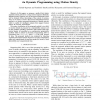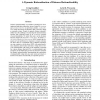170 search results - page 22 / 34 » Measuring Agent Intelligence via Hierarchies of Environments |
ICRA
2009
IEEE
14 years 3 months ago
2009
IEEE
— In this paper, we propose a method that detects repeated motion patterns in a long motion sequence efficiently. Repeated motion patterns are the structured information that ca...
AAAI
2011
12 years 9 months ago
2011
One proposed approach to managing a large complex Smart Grid is through Broker Agents who buy electrical power from distributed producers, and also sell power to consumers, via a ...
AROBOTS
2005
13 years 8 months ago
2005
In field environments it is not usually possible to provide robots in advance with valid geometric models of its environment and task element locations. The robot or robot teams ne...
AAAI
2012
11 years 11 months ago
2012
Real-world AI systems have been recently deployed which can automatically analyze the plan and tactics of tennis players. As the game-state is updated regularly at short intervals...
AAAI
2012
11 years 11 months ago
2012
Distance rationalizability is an intuitive paradigm for developing and studying voting rules: given a notion of consensus and a distance function on preference profiles, a ration...


